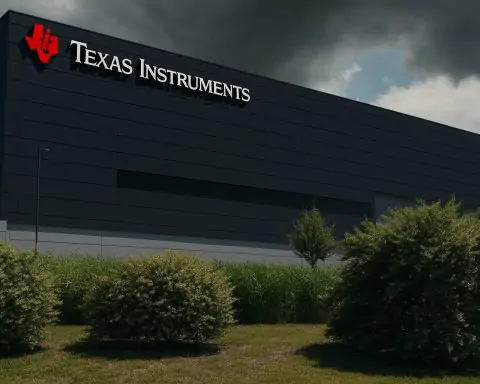Major stock indexes tumbled on Nov 5, 2025 amid AI valuations concerns and profit-taking. The Nasdaq fell about 2% and the S&P 500 around 1%, while the Dow lost ~0.5% [1]. Tech/AI giants plunged – e.g. Palantir –8%, Nvidia –4%, AMD –3.7% [2] [3] – after warnings that sky-high valuations may not hold. Wall Street heavyweights (Morgan Stanley, Goldman Sachs, JPMorgan) have warned of a coming market correction [4] [5]. Asian markets led losses (Japan and South Korea down ~5% from recent highs [6] [7]) and Europe opened lower. Safe-haven assets stirred: the CBOE VIX spiked ~10% (to ~19) [8] and Bitcoin briefly dipped under $100,000 [9]. The U.S. government shutdown – now the longest ever – and upcoming tariffs hearing are adding uncertainty [10] [11]. Many analysts call the selloff a “breather” or healthy profit-taking after a blistering tech rally [12] [13].
Global Stocks Sell Off on AI Valuation Worries
On Nov 5, stock markets around the world sharply declined after a recent surge in tech/AI shares prompted worries of an “AI bubble.” In the US on Tuesday, the tech-heavy Nasdaq suffered its biggest one-day drop in weeks, sliding ~2% while the S&P 500 fell ~1% and the Dow lost ~0.5% [14]. The Nasdaq’s fall was driven largely by heavy losses in AI-related shares – six of the “Magnificent Seven” megacaps (Nvidia, Alphabet, Meta, etc.) ended the day in the red. Wall Street closed deep in the red after Morgan Stanley and Goldman Sachs CEOs flagged “stretched” equity valuations and the risk of a pullback [15] [16]. The result: all three U.S. indexes were well off their recent all-time highs by Wednesday.
This slump followed months of record gains. “Wall Street’s worst day in almost a month” saw the S&P 500 and Nasdaq each give back over 1% [17]. Analysts note the correction came on no single big news, but on growing “unease at sky-high valuations.” One strategist said investor sentiment flipped to risk-off as lofty tech valuations finally knocked stock confidence [18]. Even the popular trading rally has hit a pause as markets price in the chance that AI-driven gains may have gone too far.
Tech & AI Stocks Lead the Decline
The biggest losers were companies tied to the AI boom. For example, Palantir Technologies (data analytics/AI) fell ~8% on Tuesday despite raising its revenue forecast – illustrating heavy profit-taking [19]. Palantir had soared over 150% year-to-date, making it especially vulnerable to a selloff. Notably, famous short-seller Michael Burry (of “Big Short” fame) publicly bet against Nvidia and Palantir, stoking volatility. Palantir’s CEO Alex Karp even took to CNBC to lash out at Burry and other short-sellers “trying to call the AI revolution into question” [20].
Chipmakers also slid hard. Nvidia – the world’s most valuable company and AI bellwether – fell roughly 4% on Tuesday [21], and Advanced Micro Devices (AMD) dropped about 3.7% [22]. In after-hours trading, AMD dipped another 3% after reporting strong earnings that nevertheless failed to satisfy investors [23]. Super Micro (SMCI), a server-maker benefitting from AI data center demand, plunged about 9% after missing profit and revenue forecasts [24]. Wall Street futures on Nov 5 pointed to further losses: AMD futures were down ~5% premarket, and SMCI futures off ~8.5% [25]. Other AI-related names – Broadcom, Intel, et al. – also traded lower pre-open [26].
One HSBC strategist warned: “With very high valuations, small news…can cause markets to come down a lot” [27]. Indeed, after rallying over 50% from spring lows, the Nasdaq’s 2% drop on Tuesday merely retraced some of that run [28]. In Asia, the rout extended Tuesday’s losses: Japan and South Korea stocks plunged more than 5% from the prior day’s peaks [29]. The downturn was broad across the tech supply chain, dragging on semiconductor indices (Philadelphia’s SOX index fell ~4% [30]) and cloud/software names. The U.S. volatility index (VIX) jumped ~10% to around 19 [31], signalling rising fear, and Bitcoin – often seen as a barometer of risk appetite – briefly dipped below $100,000 for the first time since June [32].
CEO Warnings and Market Sentiment
Prominent finance figures had long warned of an impending pullback, and their voices grew louder this week. Jamie Dimon (JPMorgan CEO) had cautioned in October that a crash could come “in the next six months to two years.” This week, Morgan Stanley’s Ted Pick and Goldman’s David Solomon reiterated that equity markets were overheated and “raised the prospect of a pullback” [33]. Their comments – alongside hawkish Fed talk and mixed economic data – helped spark traders’ jitters.
“It’s profit-taking,” explained Chuck Carlson, CEO of a Midwest advisory firm, noting that high-flying tech stocks had been “pretty stretched and earnings were good, but not great” [34]. Others describe the pullback as a healthy “breather.” Jon Withaar of Pictet Asset Management in Singapore said the decline was “largely positioning-driven,” with the recent outperformers simply giving back gains [35]. Angus McGeoch of Australia’s Barrenjoey agreed the selling has been “fairly blanket in the risk-leverage part of the market…short-term profit-taking” [36]. Even as markets fall, many see the core economy as still robust: a labor market unexpectedly adding jobs (ADP reported +42,000 private payrolls in Oct) and signs of steady consumer spending provide a silver lining. [37] [38]
Jim Reid of Deutsche Bank summed up sentiment: “The last 24 hours have brought a clear risk-off move, as concerns over lofty tech valuations have hit investor sentiment.” [39] Indeed, trading desks say many fund managers are “ducky[ing] out of downdrafts” at year-end to lock in profits, but are not yet abandoning equities. As one Sydney portfolio manager put it: “I’ve been buying today… I hope I’m right,” seeing this as an opportunity to add positions in the dip [40].
International Impact: Asia and Europe Weighed Down
The Wall Street selloff rippled globally. On Wednesday, Asian bourses registered their sharpest slide in about seven months [41]. South Korea’s KOSPI and Japan’s Nikkei indexes fell over 2% intraday [42], reflecting fear that the U.S. tech pullback would spread to local markets. Chinese stocks bucked the trend modestly – China’s government announced that new, state-funded data centers must use domestic AI chips, aiding local manufacturers [43]. In Europe, markets also opened lower: London’s FTSE, Frankfurt’s DAX and Paris’s CAC were all slightly down on the morning of Nov 5, hurt by the global tech slump [44].
The selloff even affected currencies and commodities. The Korean won fell to a seven-month low against the dollar as risk aversion spiked [45]. The euro weakened despite stronger European business surveys, and gold saw renewed buying as a hedge. Crypto investors felt the pain too: Bitcoin’s retreat under $100k wiped out its October gains, making October the worst month for BTC in a decade [46].
Other Factors Adding Uncertainty
Beyond tech valuations, other headlines are fueling caution. The U.S. government shutdown is now the longest on record (over 35 days), delaying key economic data and leaving the economy “flying blind” [47] [48]. Traders will closely watch Thursday’s ADP jobs report and other fallouts. Separately, the U.S. Supreme Court began hearings on President Trump’s trade tariffs, keeping tariff risk alive. In New York City, voters unexpectedly chose a socialist mayor, but markets shrugged it off [49] (with little effect on the finance-centric stocks).
On balance, experts say the market is digesting both domestic issues and global trends. Morgan Stanley sees solid long-term drivers (AI adoption, steady GDP growth) but now warns of possible “10-15% drawdowns” on any shock [50]. Others highlight seasonal trends: Bank of America notes that historically November tends to be strong if October finished well (with the S&P up in 59% of past Novembers) [51]. But most agree that with equities at record highs, volatility and corrections are natural – if painful – parts of the cycle.
Looking Ahead
Investors now face a crossroads. Some strategists urge caution. Jamie Dimon and other bankers advise taking chips off the table and “welcoming” modest pullbacks [52]. Financial advisors are eyeing valuations: as one pundit put it, “we’ve had outsized returns…if you haven’t rebalanced your portfolio lately, it’s worth doing it now” [53].
Others see buying opportunities. Strength in sectors like healthcare, consumer discretionary and small-caps – traditionally seasonal November winners – could cushion the impact [54]. The Fed’s policy path (with rate cuts likely in 2026) and resilient corporate profits remain positives. In the short run, market watchers expect continued choppy trading as investors sort through earnings reports (Qualcomm, Costco and others are due) and await clearer signals from Fed officials.
In summary, November 5, 2025 marks a notable selloff ignited by AI bubble fears and valuation anxiety [55] [56]. Quotes and data paint a picture of a rally taking a breather: indexes off recent highs, tech and AI stocks correcting sharply, and a wary mood among traders. Whether this becomes a deep correction or a temporary pullback depends on economic news, Fed action, and – crucially – whether AI stocks can sustain their lofty growth expectations.
Sources: Market reports and expert interviews from Nov 4–5, 2025 (CNBC, Reuters, Guardian, Nasdaq) are cited above [57] [58] [59] [60] [61] [62], providing real-time data and analysis. These include index values and sector moves from Nasdaq’s market recap [63], firsthand quotes from strategists (HSBC, Pictet, Barrenjoey) [64] [65], and commentary from global bank CEOs and policy figures.
References
1. www.reuters.com, 2. www.nasdaq.com, 3. www.reuters.com, 4. www.theguardian.com, 5. www.reuters.com, 6. www.theguardian.com, 7. www.reuters.com, 8. www.nasdaq.com, 9. www.theguardian.com, 10. www.reuters.com, 11. www.reuters.com, 12. www.reuters.com, 13. www.theguardian.com, 14. www.reuters.com, 15. www.reuters.com, 16. www.reuters.com, 17. www.reuters.com, 18. www.theguardian.com, 19. www.reuters.com, 20. www.theguardian.com, 21. www.nasdaq.com, 22. www.nasdaq.com, 23. www.reuters.com, 24. www.reuters.com, 25. www.reuters.com, 26. www.reuters.com, 27. www.reuters.com, 28. www.reuters.com, 29. www.theguardian.com, 30. www.reuters.com, 31. www.nasdaq.com, 32. www.theguardian.com, 33. www.reuters.com, 34. www.reuters.com, 35. www.reuters.com, 36. www.reuters.com, 37. stockanalysis.com, 38. economictimes.indiatimes.com, 39. www.theguardian.com, 40. www.reuters.com, 41. www.theguardian.com, 42. www.reuters.com, 43. www.reuters.com, 44. www.theguardian.com, 45. www.reuters.com, 46. www.theguardian.com, 47. www.reuters.com, 48. www.reuters.com, 49. www.reuters.com, 50. www.theguardian.com, 51. economictimes.indiatimes.com, 52. www.reuters.com, 53. stockanalysis.com, 54. economictimes.indiatimes.com, 55. www.theguardian.com, 56. www.theguardian.com, 57. www.theguardian.com, 58. www.reuters.com, 59. www.reuters.com, 60. www.theguardian.com, 61. www.reuters.com, 62. www.reuters.com, 63. www.reuters.com, 64. www.reuters.com, 65. www.reuters.com










